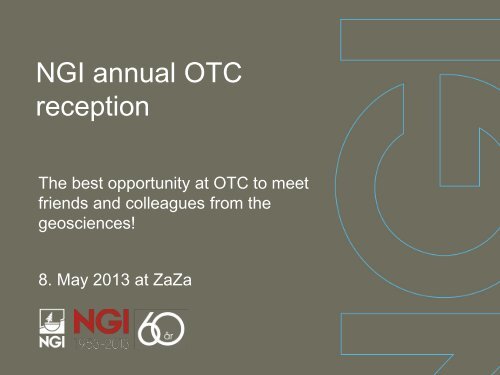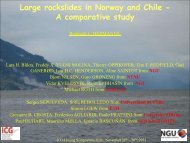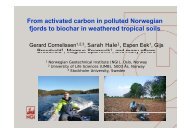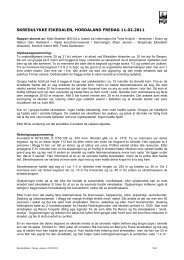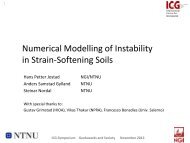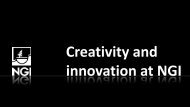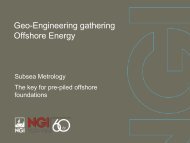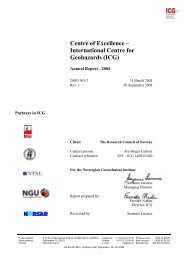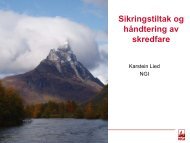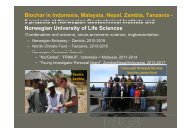NGI highlights
NGI highlights
NGI highlights
Create successful ePaper yourself
Turn your PDF publications into a flip-book with our unique Google optimized e-Paper software.
<strong>NGI</strong> annual OTC<br />
reception<br />
The best opportunity at OTC to meet<br />
friends and colleagues from the<br />
geosciences!<br />
8. May 2013 at ZaZa
<strong>NGI</strong> organization<br />
Managing Director<br />
Lars Andresen<br />
Ingrid Malnes<br />
Kjell Karlsrud, Knut H. Andersen,<br />
Farrokh Nadim<br />
Finance and Accounting<br />
Mimoun Bouhmidi<br />
HR and Information<br />
Inger Kristine Tovslid<br />
Quality Assurance and HSE<br />
Geraldine Sørum<br />
IT Services<br />
Stein Strandvik<br />
Subsidiary<br />
<strong>NGI</strong> Inc. (USA)<br />
Audun Hauge<br />
Technology innovation<br />
James Michael Strout<br />
Offshore Energy Environmental Engineering Natural Hazards Building, Construction and Transport.<br />
Karl Henrik Mokkelbost Anne Kibsgaard Anders Solheim Ørjan Nerland<br />
Offshore Geotechnics<br />
Thomas Langford<br />
Water and Resources<br />
Arne Pettersen<br />
Avalanches and Rock Slides<br />
Ulrik Domaas<br />
Onshore Foundations<br />
Magnus Rømoen<br />
Instrumentation and Monitoring<br />
Dag Tollefsrud<br />
Contaminants and Land Use<br />
Paul Sverdrup Cappelen<br />
Debris Slides and Georisk<br />
Bjørn G. Kalsnes<br />
Field Investigations<br />
Kristoffer Kåsin<br />
Petro.Geomech. and –physics (PGG)<br />
KH Mokkelbost<br />
Geomapping<br />
Andreas Aspmo Pfaffhuber<br />
<strong>NGI</strong> Trondheim<br />
Randi Skirstad Grini<br />
Computational Geomechanics<br />
Karin Norèn-Cosgriff<br />
Eng. Geology and Rock Mech.<br />
Roger Olsson<br />
Laboratory and Model Testing<br />
Morten Andreas Sjursen
Some practical issues<br />
• Safety<br />
• Parking validation<br />
• Email addresses & invitations + name tags<br />
The Boss<br />
Dewey, Cheetum and Howe<br />
59 Estreet
Your hosts this afternoon<br />
From <strong>NGI</strong> inc<br />
Audun Hauge<br />
Knut Schrøder<br />
Francisco Hernandez-Martinez<br />
Young Jae Choi<br />
Amir Rahim<br />
Victor Taboada<br />
Gokhan Saygili<br />
From <strong>NGI</strong><br />
Lars Andresen<br />
Suzanne Lacasse<br />
Maarten Vanneste<br />
James (Jim) Strout<br />
Øyvind Torgersrud<br />
Dag Tollefsrud<br />
Morten Saue<br />
Thomas Langford<br />
Karl Henrik Mokkelbost
Topics this afternoon<br />
<br />
<br />
<br />
<br />
<br />
Time effects on piles – outcome from JIP<br />
Schmertmann Research lab – operating<br />
Earth Quake loads on pipelines<br />
Offshore wind<br />
<br />
Proposal for new JIP on piles<br />
<br />
Final remark
From onland and offshore geotechnics<br />
Time effects on pile capacity<br />
A JIP project organized by <strong>NGI</strong><br />
Work by Dr Kjell Karslrud
Objective: Establish practical design<br />
procedures that account for effects of time<br />
on the axial bearing capacity of piles<br />
Elements:<br />
‣ Collect and sumarise available data on time effects axial bearing<br />
capacity<br />
‣ Perform new pile load tests in the field, with specific focus on time<br />
effects:<br />
• 6 test sites<br />
• Pile tested: Open pipe piles, typically D=400 mm, L= 20 m<br />
‣ Develop new design procedures<br />
‣ Disseminate results to ensure that they get incorporated into<br />
national and international design guidelines and codes
Selected test sites<br />
1. Normally consolidated medium plastic clay – Onsøy ,Norway<br />
2. Normally consolidated low plastic clay, Stjørdal, Norway<br />
3. Stiff overconsolidated low plastic clay, Cowden UK<br />
4. Highly plastic OC clay in the sea at Femern, German coast<br />
5. Loose sand, Larvik, Norway<br />
6. Medium dense sand, Ryggkollen near Drammen, Norway
Load testing program at each site<br />
1(2)<br />
3(4)<br />
6(8)<br />
12<br />
24<br />
Pile<br />
No.<br />
Months<br />
Months<br />
Months<br />
Months<br />
Months<br />
1 x x x x x<br />
2 x x x x<br />
3 x x x<br />
4 x x<br />
5 x<br />
6 x Sust.<br />
at<br />
60%<br />
Sust.<br />
at<br />
60%<br />
x
Some of the key findings<br />
‣ The results confirm a significant ageing effect.<br />
‣ For piles in clay the effect reduces with increasing<br />
plasticity index and OCR of the clay.<br />
‣ For piles in sand the ageing effect seems in general<br />
to be even larger than in clay! The capacity may<br />
double over a two year period.<br />
‣ Repeated load testing on the same pile gives an<br />
incorrect picture of ageing effects.<br />
‣ Still possible to join the JIP – there are more work<br />
and more info that can be extracted from the program<br />
Work by Dr Kjell Karslrud
Schmertmann Research lab (SRL) – running
New Carbon fibre triaxial cell for tests in CT scanner<br />
New carbon cell that allows for anisotropic<br />
consolidation of rock plug<br />
X-ray imaging of rock core and saturation<br />
during flow and deformation testing<br />
• Main Features<br />
• Sample dimension 38 mm diameter, 100 mm length<br />
• Axial load 100 kN (88 MPa on 38 mm sample)<br />
• Radial confinement: 70 MPa<br />
• Pore pressure: 70 MPa<br />
• Working temp. 140 deg C<br />
• Suitable for corrosive fluids<br />
• Balanced piston or external load frame.<br />
• Axial Vp, Vs, and R<br />
• Axial and radial strain measurements<br />
• 12 radial acoustic pinducers, fittings for 25 mm samples<br />
New
New direct shear box for testing on fractured material<br />
<br />
<br />
<br />
<br />
For testing of intact or fractured rock<br />
Measure direct shear strength, friction and<br />
deformation behavior<br />
Conductivity of fracture during normal<br />
stress and shear at high stresses<br />
Applications related to CO2 storage and<br />
testing of shale gas<br />
Main Features<br />
• Max specimen dimensions 150x150x300 mm.<br />
• Max shear force: 250 kN<br />
• Max shear displacement: 100 mm<br />
• Max normal force: 500 kN<br />
• Max pore pressure: 2 MPa<br />
• Max flow gradient: 4 MPa<br />
• Future option for ultrasonic velocity transducers<br />
Test on<br />
Natural<br />
Fracture in<br />
shale<br />
Before test<br />
After test
CGM<br />
Pipelines under earthquake-induced soil movements<br />
• Pipelines traversing slopes are<br />
subjected to down slope movements<br />
of slopes during earthquakes.<br />
• In moderate to steep slopes in deep<br />
water one could expect down slope<br />
displacements larger than 1 m under<br />
even moderate earthquake events.<br />
• As part of JIP (Earthquake Effects in<br />
Deep Water) at <strong>NGI</strong> a solution has<br />
been developed for computing forces<br />
in pipelines over slopes. The solution<br />
is based on computing accelerations<br />
along the slope, and applying them to<br />
3-D FE model of pipeline supported<br />
on strain-softening springs.<br />
Contours of permanent displacements<br />
Deformations due to earthquake<br />
Work by Amir Kaynia
Sample results of<br />
analyses<br />
Maximum forces along<br />
pipeline during<br />
earthquake<br />
Maximum axial force (kN)<br />
2 500<br />
2 000<br />
1 500<br />
1 000<br />
500<br />
0<br />
-500 0 500 1 000 1 500 2 000 2 500<br />
Distance along pipeline (m)<br />
Maximum bending<br />
moment along pipeline<br />
during earthquake<br />
Max. bending moment (kNm)<br />
80<br />
70<br />
60<br />
50<br />
40<br />
30<br />
20<br />
10<br />
0<br />
-500 0 500 1 000 1 500 2 000 2 500<br />
Distance along pipeline (m)<br />
Work by Amir Kaynia
From Offshore geotechnics<br />
Offshore wind energy development – North Sea<br />
<strong>NGI</strong> projects include the last 10 years:<br />
<br />
<br />
<br />
<br />
Classic soil investigations<br />
Laboratory testing<br />
Foundation design for jackets and<br />
Gravity base towers<br />
Studies on foundation types.<br />
More info OWF Thursday morning<br />
Morten Saue Key note at OTC<br />
Dolwin 2, Aibel
Dolwin 2, Aibel
Subsea Leak Detection (SLD) system<br />
In place overview
Concept:<br />
Modular instrument node on subsea network<br />
Lifting yoke<br />
with Imenco connector<br />
“Mobile”<br />
Instrument<br />
module<br />
In operation<br />
Bullseye<br />
Parking slots<br />
for ROV stabs<br />
“Permanent”<br />
Seabed frame
Instrument Module<br />
Not visible in this image:<br />
sensors for measuring<br />
dissolved methane<br />
Horizontal<br />
Scanning<br />
Sonar head<br />
Vertical<br />
Scanning<br />
Sonar head<br />
Parked<br />
Aquadopp<br />
Current meter
Prototype system installation<br />
Seabed frames<br />
Monitoring modules and riser umbilical<br />
Docking Instrument module to seabed frame<br />
Hooking up COM and power line<br />
“Watch tower” on duty<br />
Subsea images: DeepOcean (responsible for installation)<br />
Subsea image: Stinger Technology AS<br />
PM at <strong>NGI</strong> was Dag Tollefsrud<br />
Jim Strout
NEW JIP on pile design??<br />
Suzanne has some ideas on that!
Proposal for a JIP<br />
Reliability of API, <strong>NGI</strong>, ICP, UWA and Fugro<br />
Axial Pile Capacity Calculation Methods<br />
• A joint effort<br />
• Needs sponsorship
Motivation<br />
• In our designs, we need to ensure the same level<br />
of safety for the new pile capacity (read CPT)<br />
methods as for the API method.<br />
• The designer is required to select an appropriate<br />
safety factor when using the CPT methods.<br />
• One can choose to be conservative and apply a<br />
“high” safety factor, or one can document the<br />
level of safety and “calibrate” the required safety<br />
factor(s) that ensures a target level of safety.
Motivation<br />
The industry needs<br />
• Guidelines on the safety factor to use with the<br />
”newer” CPT methods.<br />
• A consensus on the model uncertainty in the methods<br />
(will reduce the uncertainty and thereby reduce the<br />
probability of failure).<br />
• The most cost-effective design as possible for piles<br />
(e.g. reduce pile penetration depth where possible).
Three targets<br />
• Calibration of material factor for enough case studies<br />
so that one can generalise conclusions (OTC paper<br />
gives results for two sites that are site-specific)<br />
• Consensus on pile load test database, and<br />
publication of the database on the web<br />
• Transfer conclusions to design guidelines (API,<br />
ISO/OGP)
Modus operandi - Operator and ”expert ” involvement<br />
Calibration of safety factor(s)<br />
3-4 sites mainly clays; 3-4 sites mainly sand;<br />
3-4 sites intermixed; 2-4 sites w/ ”unusual” cond.<br />
Each sponsor to provide 2-3 case studies<br />
Sponsors can send own staff to <strong>NGI</strong> to do analyses for their<br />
own case studies<br />
Consensus on pile load test database and web publication<br />
Start with UWA’s careful work<br />
Find new large dia pile load tests<br />
Panel of experts (e.g. Jardine, Lehane, Jeanjean, Gilbert,<br />
Senders, Frimann Clausen etc) to accept/reject load<br />
tests to be included in ”consensus database”<br />
(parameters, interpretation of pile load tests, backcalculation).<br />
Job is not done until we have agreement.<br />
Complete the work in first 2 ½ years of 4-yr project.
Deliverables<br />
Calibration of material factor<br />
• 14-16 case studies (3 already done)<br />
• Method and examples<br />
‣Quantify uncertainties in soil parameters<br />
‣Quantify model uncertainty, including how to include<br />
uncertainty for large pile diameters, low plasticity, etc<br />
‣Uncertainties in effects of cyclic loading and of time on<br />
pile capacity<br />
‣Uncertainty in pile capacity and P f<br />
‣Calibration of safety factor(s).
Deliverables<br />
Consensus on pile load test database<br />
• No more discussion on which test gave what result,<br />
on ”our interpretation is more reliable than yours”!<br />
• Flexible database where on can include new pile<br />
load tests<br />
• Solution for the custody of web site and database<br />
after the JIP is completed
Proposed budget and sponsorship<br />
Budget<br />
• Calibration of material factor<br />
USD 2,2 M over 4 years<br />
• Consensus on pile load test database<br />
USD 1 M over 2 ½ years<br />
Sponsorship<br />
• 8 sponsors @ USD 100,000/yr × 4 yrs or<br />
• 10 sponsors @ USD 80,000/yr × 4 yrs<br />
Next step
<strong>NGI</strong> Inc – Change of President<br />
Knut Schrøder 2002 – 2008<br />
Stein Strandvik 2008 – 2010<br />
Audun Hauge 2010 – 2013<br />
Morten Saue 2013 ->


